Contents
- Description of the drug Prophylactin
- What pests does Prophylactin help with?
- Composition and form of release of the drug Prophylactin
- How does prophylactin work?
- Advantages and disadvantages
- When to spray trees with Prophylactin in the spring
- How to prepare a solution of Prophylactin for the garden
- Instructions for use of the drug Prophylactin for the garden
- Compatibility with other drugs
- Analogues of Prophylactin
- Safety Precautions
- Storage conditions and shelf life of Prophylactin
- FAQ
- Conclusion
- Reviews about the drug Prophylactin from a complex of pests


Pests are a problem that all gardeners face on personal plots. If you do not fight them, you can lose most or even the entire crop. However, there are preparations that allow you to protect “cultivated” plants from pest attacks for the whole season after a single spring treatment. Among them is Prophylactin for the garden. Of course, it will benefit the garden only if you strictly follow the instructions given in the manufacturer’s instructions, especially regarding the dosage of the insecticide and its consumption rate.
Description of the drug Prophylactin
Prophylactin is a broad-spectrum insecticide with an ovicidal effect. The chemical destroys not only adults, but also insects at earlier stages of development, including their eggs.
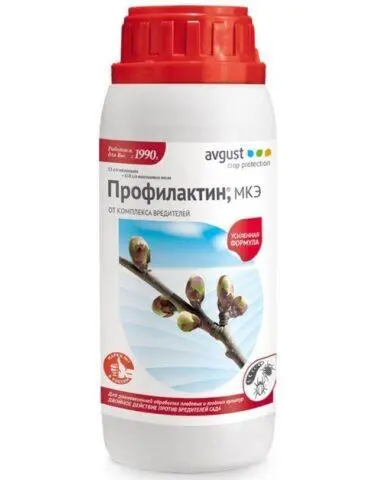
Prophylactin is produced by the company “August”, officially approved for processing plantings on personal plots
The drug is used mainly for spraying pome and stone fruit trees, berry bushes. The only treatment allows you to protect plantings for the entire season.
What pests does Prophylactin help with?
Processing allows you to protect plants from most of the most common pests:
- herbivorous mites (spider, kidney, felt);
- shields and false shields;
- leaflets;
- all kinds of aphids;
- butterfly caterpillars (whites, scoops);
- suckers;
- thrips.
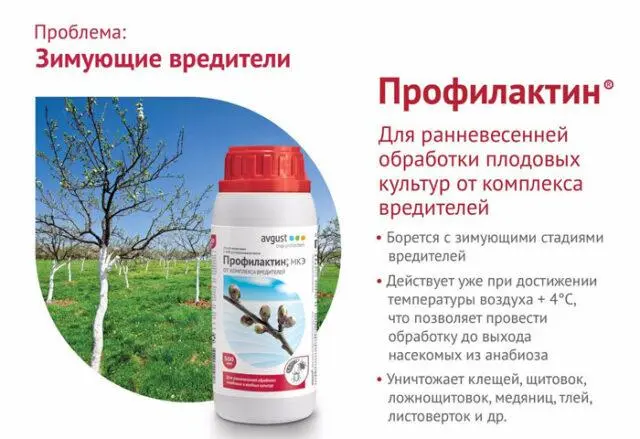
Insectoacaricide Prophylactin is widely used for treatments not only by amateur gardeners, but also by professional farmers
Composition and form of release of the drug Prophylactin
The basis of the preparation is mineral vaseline oil (658 g/l). The only active ingredient is malathion (aka Karbofos) at a concentration of 13 g / l. This substance is from the class of organophosphates (FOS), it has been widely used in the production of insecticides for plant treatments since the 50s of the twentieth century.
The manufacturer produces insectoacaricide in plastic bottles of 500 ml or 1 liter. The letters MKE present in the name stand for “oil emulsion concentrate”.
For insecticides and insectoacaricides, this is a relatively new form of release. The active substance of the drug Prophylactin is, as it were, “encapsulated” in the smallest drops of mineral oil with a diameter of not more than 200 nm.
Due to this, its ability to “absorb” into tissues after processing increases dramatically. Insecticides in the form of an emulsion microconcentrate provide the longest protective effect and powerful action, and they are not affected in any way by precipitation and other weather factors.
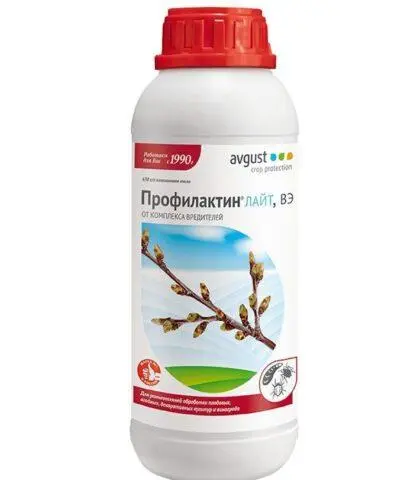
Until recently, the drug was produced in two versions – as an aqueous and oily emulsion, now the first one has been discontinued
How does prophylactin work?
Prophylactin is an insectoacaricide of intestinal-contact action. After processing, it enters the body of pests through direct contact, “absorbing” through chitinous and other protective membranes, or through the digestive tract during nutrition.
Like any organophosphorus compound, malathion for insects and mites is a neurotoxin that “blocks” the transmission of “commands” from nerve cells to all organs and systems. First, the pest poisoned by the drug is affected by convulsions, then complete paralysis and death follow.
Advantages and disadvantages
Popularity among gardeners insectoacaricide Prophylactin owes its undoubted advantages:
- Providing protection against wintering pests, which allows to initially significantly reduce their numbers and prevent the mass development of the population after processing, even if the weather and other factors favor this.
- Combination of insecticidal, acaricidal and ovicidal properties.
- Effectiveness against many pests, most of which have long been well known to gardeners and are distinguished by their “omnivorous nature”.
- Long-term protective effect of the drug.
- An improved form of release, providing a quick action of the drug, high “migration” ability and its “independence” from the vagaries of the weather. However, treatment with Prophylactin immediately before rain is not recommended, the desired interval between spraying and precipitation is 2-3 hours.
- Plant protection after treatment for at least 30 days. This is just enough for the period of mass spring summer of pests after the winter “hibernation”. The peak of their activity falls on May. Depending on the climate in the region, it can “shift” to the second half of April or the beginning of June.
- Wide application temperature range. Prophylactin begins to act already at 4 ° C. As it warms, its effectiveness increases simultaneously with the activation of pests.
- No phytotoxicity. Treatment with the drug does not affect the growth and development of fruit trees and berry bushes, the volume and quality of the crop. Collected fruits and berries can be safely eaten. The drug breaks down into “neutral” compounds and is completely removed from plant tissues in two months.
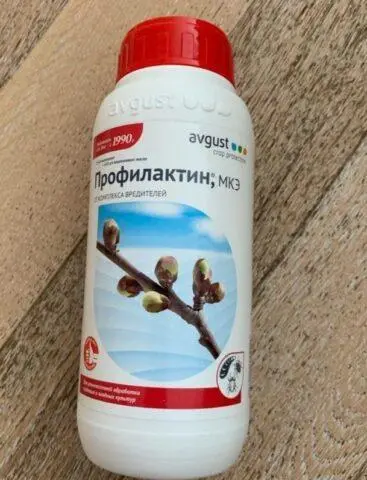
Prophylactin is suitable for processing most pome and stone fruits, gooseberries, currants
The insectoacaricide Prophylactin also has some disadvantages:
- The property of resistance common to all preparations based on malathion. It is because of him that re-treatment of plantings with insectoacaricide Prophylactin is not allowed. Although some gardeners, on the contrary, consider this feature to be a virtue – the property of resistance allows them to limit themselves to a single spraying during the season.
- The impossibility of processing fruit and berry and fruit and vegetable crops with a thin and delicate skin of the fruit. The maximum permissible concentration of the active ingredient in them will exceed the norm that is safe for human health and will not decrease even with a very long waiting period. Therefore, it is impossible to treat Prophylactin in early spring, for example, strawberries.
- Unsuitability of the drug for the preparation of tank mixtures.
- Possibility of storage only in undamaged original packaging. The opened vial should be used at one time.
When to spray trees with Prophylactin in the spring
The lower temperature limit at which the insectoacaricide Prophylactin begins to act favorably distinguishes it from other drugs with a similar effect. Pests are destroyed while they are still in a state of hibernation, and trees and shrubs are just “waking up”.
Landing processing is carried out from the moment of the final snow melting to the stage of the “green cone” of the kidneys. If leaves have already begun to bloom on trees and bushes, you need to look for other preparations to protect against insects.
How to prepare a solution of Prophylactin for the garden
Prophylactin for spraying trees and shrubs should be diluted at a concentration of 0,5 liters per 10 liters of water. The solution is prepared extremely simply and quickly. First, about a third of the volume of water is poured into the container from which the gardener will spray the plantings, and the emulsion is added there. Both ingredients are intensively mixed until smooth and the remaining water is poured into the solution.
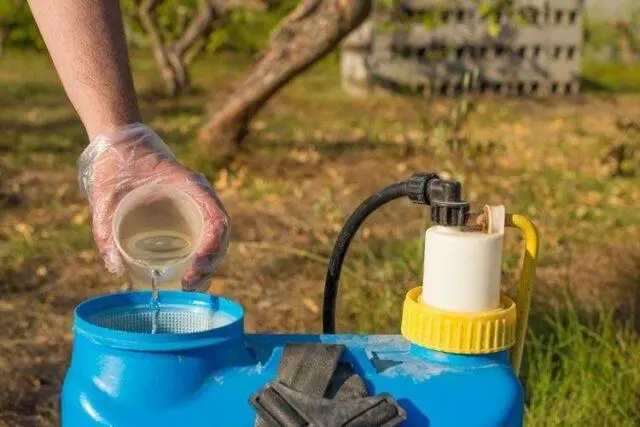
You need to use the solution as quickly as possible, after 5-6 hours the liquid loses its protective properties
Instructions for use of the drug Prophylactin for the garden
For the treatment of trees and shrubs in the garden with Prophylactin, choose early morning or late evening on a dry, windless day. Direct sunlight and gusts of wind quickly “dry” vaseline oil, reducing the penetrating power of the drug.
Trees and shrubs should be sprayed with a working solution as evenly as possible. Sanitary pruning is preliminarily carried out, peeling of exfoliated bark, treatment of “wounds” with garden pitch.

Any other agrochemicals are used after treatment with Prophylactin
Compatibility with other drugs
The manufacturer’s instructions specifically emphasize that it is strongly not recommended to mix Prophylactin with other agrochemicals (pesticides, insecticides, fungicides, biostimulants). Even in slightly acidic and slightly alkaline, not to mention more “aggressive” environments, the nanostructure of the emulsion is destroyed, its effectiveness is practically reduced to zero.
Analogues of Prophylactin
There are a lot of insecticides, the main active component of which, like Prophylactin, is malathion. Preparations are popular among gardeners:
- Alatar;
- Iskra-M;
- Fufanon;
- Foscon;
- Aliot.
The mechanism of action of these insecticides is the same. The basis of the drug, the concentration of the active substance and the presence of “auxiliary” ingredients differ.
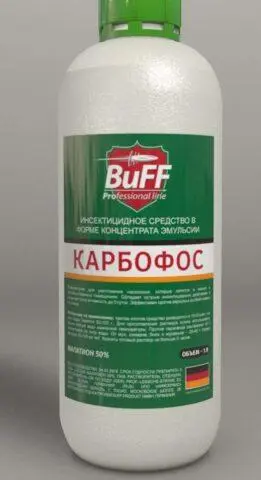
Prophylactin is one of the modern alternatives to Karbofos, which is banned in many countries due to environmental hazards.
Safety Precautions
Insectoacaricide Prophylactin MCE belongs to the III class of danger, that is, it is considered moderately dangerous for humans. However, when working with it, basic precautions must be observed:
- Use respiratory protection, mucous membranes (glasses, respirators).
- Wear tight clothes with long sleeves and trousers, minimizing the risk of getting the drug and its solution on bare skin, closed shoes, waterproof durable gloves.
- Refrain from eating, drinking, smoking during treatment.
- Prepare the solution only in containers not intended for storing food, feed, drinking water.
- Try not to overly delay the process of working with the drug. Ideally, you need to keep within 1-1,5 hours.
- After spraying, take a warm shower as soon as possible, wash clothes.
- Consider “safety zones”: 150 m to children’s, medical, recreational institutions, 15 m for residential buildings and premises where livestock is kept, 5 m for buildings and structures for household purposes, other plantings that are not subject to treatment with Prophylactin.
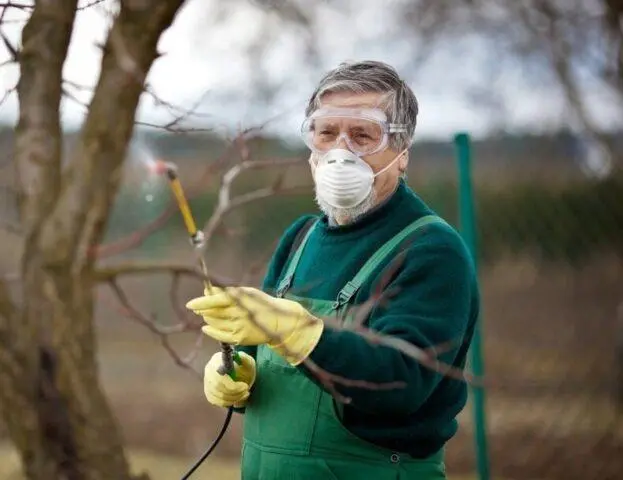
Even if security measures seem like overinsurance, they should not be taken lightly.
If Prophylactin gets on the skin or mucous membranes, it is washed off with running cool water. It is impossible to rub the “affected” place strongly. If a chemical has caused an allergic reaction, as evidenced by swelling, redness, burning, itching, or a rash, you should take any antihistamine and consult a doctor.
Accidental ingestion of the drug in its pure form or its solution requires immediate gastric lavage. You need to drink several glasses of a bright pink solution of potassium permanganate, induce vomiting. Then – take activated charcoal or any other enterosorbent. When this does not help and symptoms appear that indicate poisoning, an immediate appeal to a toxicologist is required.
Storage conditions and shelf life of Prophylactin
The shelf life of the insectoacaricide Prophylactin in unopened packaging is two years. Mandatory storage requirements are protection from direct sunlight and low humidity. It is desirable that it be cool, but the drug does not lose its effectiveness at a temperature of -20-30 ° C.

The expiration date of Prophylactin indicated on the package is “relevant” only for unopened vials
Like any other agrochemicals, this preparation must be kept in a place that excludes accidental access to it by children and pets. Containers are placed separately from food, feed, medicines, household chemicals.
FAQ
On the packaging of the drug, the manufacturer gives detailed instructions for its use. However, some questions remain unanswered.
Is prophylactin dangerous for animals
For any warm-blooded animals, as well as for humans, Prophylactin belongs to the III class of danger, that is, it is moderately dangerous. However, in order to avoid poisoning, pets must be “isolated” in advance, excluding their access to the treatment area during the spraying process and at least for a day after it.
Is it possible to treat conifers with Prophylactin
For evergreen coniferous plants, insectoacaricide Prophylactin cannot be used. Its base – vaseline oil – “clogs” the stomata on the needles, preventing normal air exchange. The decorativeness and endurance of processed specimens suffer greatly. You should not experiment and use Prophylactin to treat needles even once.
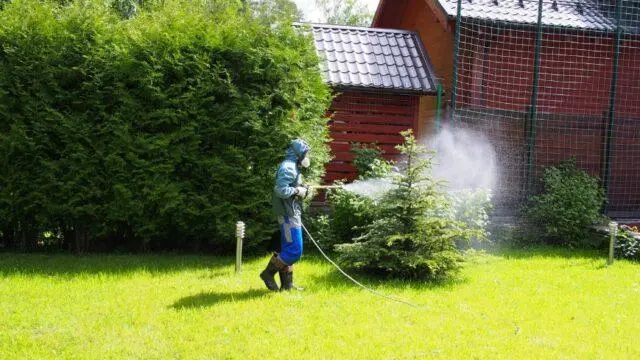
Coniferous plants are treated with insecticides and other water-based agrochemicals
Is it possible to use Prophylactin if minus at night
The lower limit at which the effectiveness of the drug is maintained is 4 ° C. This applies to both daytime and nighttime temperatures.
What can be added to profilaktin
The manufacturer in the instructions directly warns against the inadmissibility of “experiments” on mixing Prophylactin with other agrochemicals. Otherwise, the “structure” of the drug is violated, its effectiveness drops dramatically or is completely reduced to nothing. A chemical reaction is also quite likely, which an amateur gardener is not able to predict.
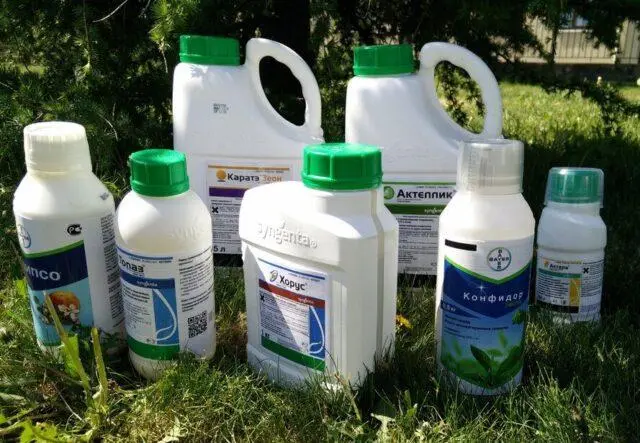
The manufacturer does not recommend mixing Prophylactin with other chemicals even for professional agronomists, not to mention amateur gardeners
Conclusion
Prophylactin for the garden is a broad-spectrum insecticide that affects not only adult pests, but also their larvae and eggs. A single treatment in the spring is enough to provide “cultivated” plants with protection from insect attacks for the entire season. Prophylactin is officially recognized as moderately dangerous to humans, however, when working with it, it is necessary to use personal protective equipment and follow the instructions for the drug.









